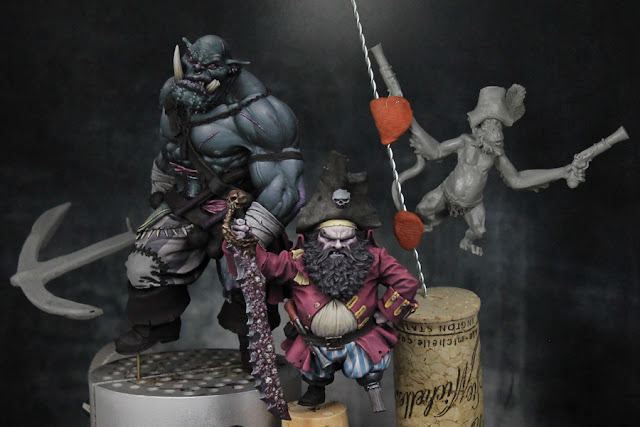It's been almost a year since I've done any painting on Redghar. As often happens, I get to a point on a figure where I'm not quite sure how to move forward. So I set it aside, work on other projects, and come back to it when I've had a chance to come up with a solution. With Redghar my issue was the leather parts. I find leather is tricky because you're painting texture along with highlights and shadows, so it's not something I feel 100% confident with (though I feel I'm getting a better handle on it). However, my issue here was more a matter of color. I did not feel the tradition brown-yellow leather colors would look good with the color palette I'd been using for the orc. So I put this project on hold until I could come up with a mix I liked.
As often happens, my work on a different project ends up helping me figure out how to do a different one. In this case it was my work on the Orc Brave. I mixed some basic browns with the teals I used in his skin, creating a dull (slightly greenish) brown that I thought would work well on Redghar. I made one further modification, mixing Burgundy Wine into the shadows (since that is the shadow tone used on the skin, red sash, and purple parts of the orc). The mix for the brown leather was...
Shadow: 50/50 Walnut Brown and Burgundy WineMidtone: 60/40 Basic Dirt and Marine Teal
Highlight: 90/10 Terran Khaki and Surf Aqua
Top Highlight: Vampiric Shadow
I used this for the leather plate cover his waist. For the belt on top of the sash, I decided to do a black leather. The approach for that came from seeing Ben Komets' work on his Uther bust. There were some nice black leather portions on there. My version used a mix of Black and Marine Teal as a substitute for the Dark Sea Blue. Highlights were done with Vampiric Shadow.




From there, I continued on with the leather work and tackled the strap around his chest. Like on the belt, I tried to bring out the cracks and scratches.


Here are a couple close ups. You can click on them for the full res version.
So, with Redghar back on track, I put some more thought into what I plan on doing with him when I'm finished. For a while now I've been tempted to pair him with the dwarf pirate (another figure I'd almost finished). Though they are from different ranges, I thought they fit well together. You've got the diminutive captain and his big enforcer. I wanted to create a diorama of a pirate crew, but felt they needed a third crew member. I had a few ideas, but nothing that seemed perfect. After some more thought, I decided I will use one of the monkey's from the Black Sailors line (where Redghar is from). That figure will need some converting. I'd like to reposition the arms, legs, and tail. But, I think that's within my abilities. If I screw it up... well, the monkey wasn't that expensive a figure to begin with. I did a quick mock up of how I think the scene will look. Redghar and the dwarf will be on the deck of the ship and the monkey will be hanging from the rigging (pointing his gun off towards the right).
I'm going to redo a decent amount of the dwarf to bring him in line with Redghar. The contrast isn't bad, but I wasn't pushing it as far as I am on the orc. I'm sure it will be a while before the whole scene is done (I do need to get back to the Orc Brave soon to finish that piece up). But I think this piece could be done in time for Adepticon and Crystal Brush. I don't expect it to win in an ultra competitive category like Diorama... but if I can just make the cut I'll be very pleased.












